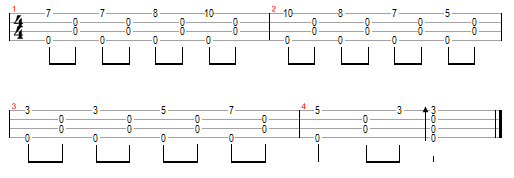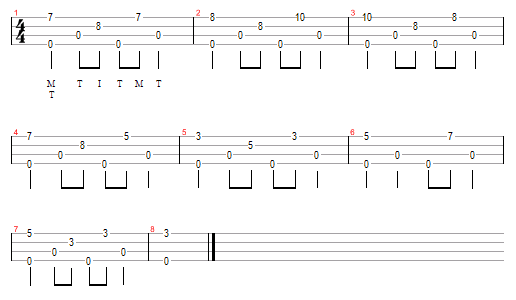A few ideas for people who want to start making their own arrangements of tunes.
For this post I’ll be using Ode to Joy because the melody is very simple and you can play it against one chord (in this case C). Here’s the snippet:
You’ll have to forgive any sniffles, coughs and hocked loogies you can pick up on these MP3s. I’m down with a nasty cold at the moment.
Melody and Strums
The most common way to combine melody and chords is to strum the chord and add the melody note on top of that.
In this case, we can strum the open g, C and E strings (make up a C chord) while we play the melody on the top string.
To make the melody note stand out make sure it’s the last note you hit. So when the melody is on the A string use a down strum, when it’s on the g-string use an up strum. Because the melody here is all on the A-string, you use all down strums. I’m using my thumb for the strums and the single notes but for more complicated pieces varying your strumming and picking will make things more interesting.
Check out Mark Occhionero arrangement of Blue in Green for an idea of what you can do with this technique.
Melody and Harmony and Strum
You can spice up the chord soloing idea by harmonizing the melody. Here I’m harmonizing with notes a third below the melody.
Back-up Picking
Here we’re adding in a simple fingerpicking pattern behind the melody. The picking hand is one finger per string (thumb on g-string, index on C-string, middle on E-string, ring on A string).
There are all sorts of patterns you can use for this type of accompaniment. Take a listen to Rick Hulett’s arrangement of Falling Slowly for some ideas.
Alternate Picking
Fingerpicking again but this time, rather than having a dedicated finger for each string, the thumb flips between the g and C strings. On the guitar this type of playing is referred to as Travis picking or Cotten picking.
Here’s a typical pattern with the thumb playing the g and C strings, the index on the E and the middle on the A.
And here’s how you could use the pattern to play Ode to Joy.
Here are a couple of tunes played in this way.
Which is the Best?
The one that sounds best to you.
There isn’t a right answer. Try them all out (and try it campanella style).
I’ve already put up two arrangements of Ode to Joy and neither of them sound anything like any of the arrangements on this post. If I was going to pick one for this tune, I’d go with the alternate picking. Which I never even thought of trying before this post.
There are so many ways of arranging any tune the only way to go is choose the one that suits you best rather than blindly copying the way it works for someone else.









Fantastic post, some really good ideas for me to try there. Thank you!